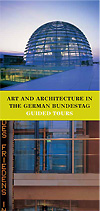Navigationspfad: Homepage > Art and History > Art > Artists
Jens Liebchen
Born in 1970 in Bonn, lives and works in Berlin.
In its efforts to acquire appropriate artworks to display in the Reichstag Building and the adjoining parliamentary buildings, the German Bundestag has invited many German and international artists to submit designs or competition entries. From the outset, Jens Liebchen has observed this process with his camera. This has created an autonomous body of photographic work, which functions at a second level parallel to the various art projectsrooted in direct responses to the building’s architecture. Figures as different as Gerhard Richter, Sigmar Polke, Jenny Holzer, Georg Baselitz, Grisha Bruskin, Neo Rauch, Jörg Herold and Franka Hörnschemeyer have all been photographed by Jens Liebchen during the conception or installation of their artworks in the parliamentary buildings.
Jens Liebchen has photographed many prominent artists in front of their works in the Reichstag Building. The results are unique portraits of these artists that reveal the individuality of each artistic personality and, at the same time, explore the tense relationship between the imposing public architecture and the artworks placed in this political environment. Taken as a whole, the portraits provide a fascinating survey of the current art scene, from its recognised international ‘stars’ to a younger generation of emerging artists.
What gives Jens Liebchen’s project its particular significance is the fact that it documents and photographically interprets an extraordinary moment in German parliamentary history. Never before has the German parliament devoted so much attention to the presentation of art in its own buildings in a comparable way. Never before has it shown such willingness to embrace the risks involved in engagement with artistic creativity.
And this is not just a one-way street: never before have such significant artists been prepared to enter into dialogue with politics. Thus, the planning and construction of the German Bundestag’s buildings in Berlin opened a new chapter in the often problematic history of encounters between the two spheres of art and politics.
And it is the great achievement of Jens Liebchen’s photographs that they use visual means to bring alive the vibrant creative atmosphere that has developed and the highly charged relationship between the artists and the political space that surrounds them. Some appear wary, some adopt a demonstratively down-to-earth approach or show a quiet self-confidence, while some play the clown as a way of masking their own unease. By capturing such reactions, the photographs do not just offer insights into the intellectual and aesthetic attitudes of the artists and their views of politics.
The images also draw attention to the view that parliamentary representatives have of their role, their portrayal of this role and its conscious expression through the artists’ creative work. Jens Liebchen’s photographs, a selection of which are on display in the restaurant, are also documents of the fruitful exchange between these very different worlds.


